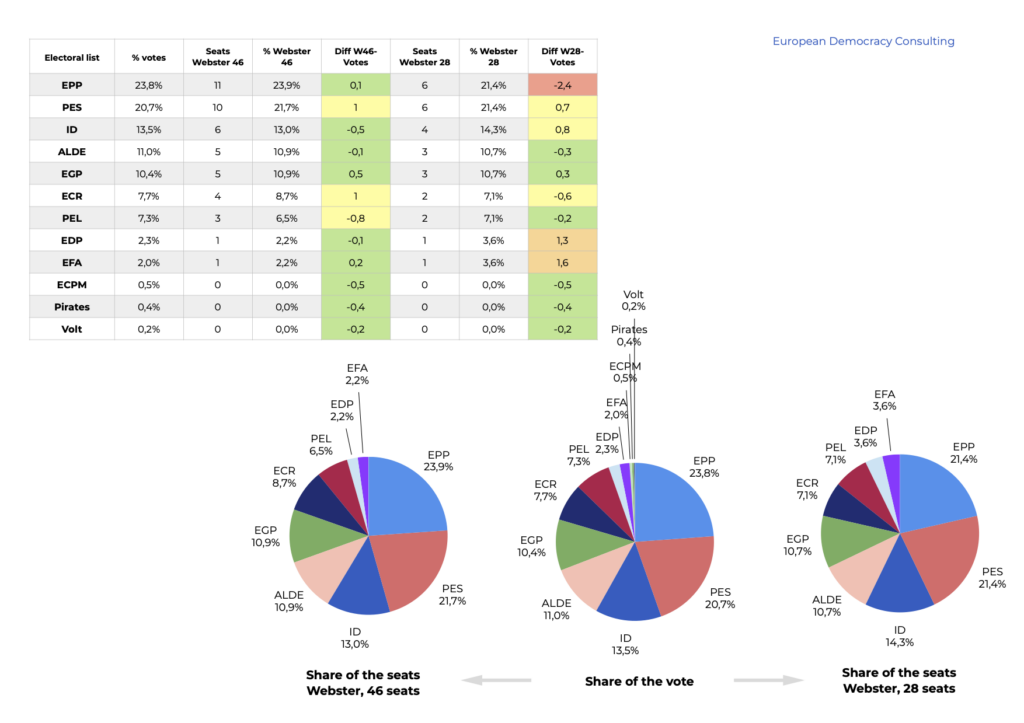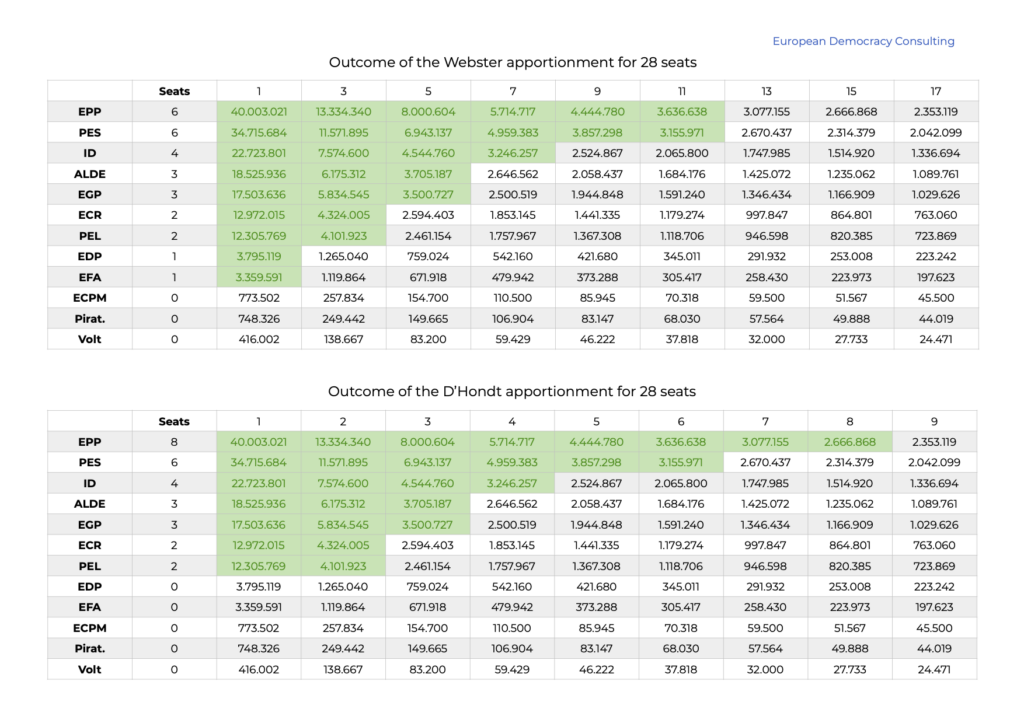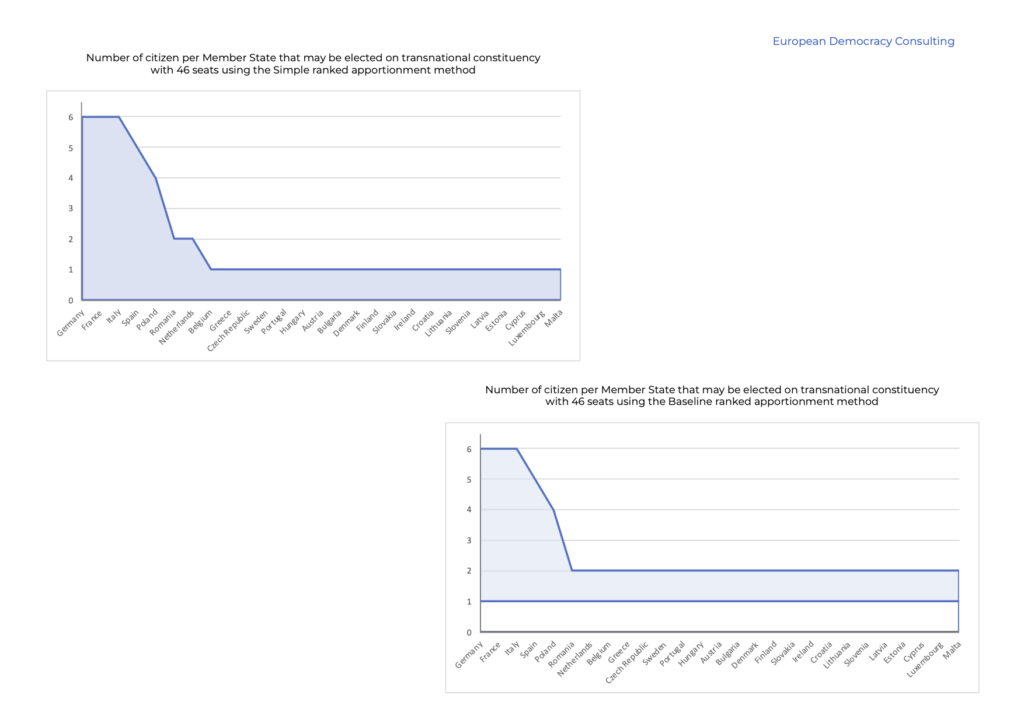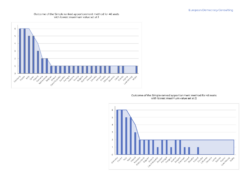The reform of the EU’s Electoral Act is one of the most consequential reforms for the future of European democracy. Members of the European Parliament’s Committee for Constitutional Affairs (AFCO) are scheduled to vote on a proposal on 28 March 2022. This report critically analyses the proposal’s provisions with regards to the creation of a transnational constituency; it argues that a vote should be postponed until key provisions are reviewed. Given the limited size of this constituency and the vast demographic differences between Member States, there is no perfect solution; however, we can ensure a best possible outcome by filling as many seats as possible, by using an apportionment method that properly reflects European parties’ electoral performance, and by choosing a sound distribution method that successfully avoids all cases of over-representation, does not entrench arbitrary groups, and balances the diverse representation of Member States with the democratic representation of citizens. Failure to do so would alienate precious and needed support in the Plenary and in the Council.
[Edit: compromise amendments were made available on 28 March; the content of this quick review is updated accordingly. Search for brackets to find them.]
Context
On 9 March, several AFCO rapporteurs and shadow rapporteurs on the reform of the EU electoral act announced reaching a tentative deal allowing discussions to move forward. Information on this deal was limited, but it was said to comprise, among others, a transnational constituency of 28 seats elected on a second vote, the conditional right for European movements (and not just officially registered European parties) to run for these seats, the use of zipped lists to improve gender balance, and a right to stand as a candidate lowered to 18 years of age.
This announcement was welcomed by the pro-European community as a victory paving the way for truly European elections. While recognising this as a step forward (especially with regards to age-related measures and easier access to postal and proxy voting), European Democracy Consulting was more measured in its reaction. After running some numbers, we published a first response highlighting perceived shortcomings in this deal. Unfortunately, less than one week before the vote, the details of this deal are still not publicly available; this quick review will therefore make use of the the limited information published, as well as of the initial report and some of its proposed amendments. It will be updated as more information becomes available. [Compromise amendments detailing the proposed deal were made available on the morning of the vote and are reflected here in brackets.]
European Democracy Consulting has always argued that merely adding a few seats on a small transnational constituency was not the real reform the EU needed in order to balance a legislative representation as close as possible to citizens, on the one hand, with proper political representation across the EU, on the other. Instead, we support a more far-reaching reform, whereby around half of the European Parliament is elected from very local, single-MEP constituencies using Majority Judgment, and the other half is elected from Member State-wide lists ensuring overall proportionality. In this proposal, candidates for local constituencies and State-wide lists would be running under the exclusive name of a European electoral list (be it a European party, a coalition of European parties, or a citizen-led list). This system is presented in more detail in the Improved Bundestag method.
However, with transnational lists gaining traction in the European Parliament and among Member States, we argued that, at least, these lists should be implemented well. This meant that, beyond modalities relating to the organisation of the election (voting age, postal voting, zipped lists, etc.), the underlying system for the election of MEPs would respect three basic criteria: sufficient seats for the new transnational constituency (at least 40), a neutral apportionment method, and a fair distribution of seats between European parties and electoral lists, and between Member States. These three measures are not mere details or pro-European arguments, they are the key to ensuring a properly democratic electoral system that works for all citizens and parties.
Note: for ease of reading, we will refer, in this quick review, to European political parties; however, in our view, electoral lists need not be limited to officially registered European parties.
The number of seats
The proposed deal only provides for 28 seats for the newly created transnational constituency. [This information, which was made public on 9 March, is confirmed in the compromise amendments.] As a result, this constituency would only account for 3.8% of the enlarged Parliament. While better than previously discussed numbers (with some proposals suggesting at low as 7 seats), 28 seats are not enough to fairly represent the political diversity of European citizens.
The table below shows the impact of reducing the number of seats for the transnational constituency, using the vote results of the 2019 European election. We see that limiting the number of seats on the transnational constituency directly affects each list’s level of representation and is detrimental to the principle of proportionality.
The initial report did not include an electoral threshold for the transnational constituency. In the example above, we see a natural threshold around 2%; any threshold above this value would further limit the number of parties elected on this constituency and, therefore, European citizens’ political pluralism.
Even more importantly, 28 seats are not sufficient to fairly represent Member States on transnational lists. One the one hand, each Member State could be guaranteed at least a seat, but this would lead to extremely high levels of over-representation for the citizens of smaller States and of under-representation for those of larger States. In this sense, any system where the citizens of Germany and of Malta have the same number of representatives cannot be considered properly democratic.1
On the other hand, if seats are not guaranteed to all Member States, it is highly likely that many Member States will not see their citizens elected on the transnational constituency. For the sake of the proper representation of Member State, we should strive to decrease the number of Member States with citizens over-represented on the transnational constituency. An easy pitfall, and worst-case scenario, would see both a lack of representation for many Member States and the over-representation of smaller Member States.
While the precise level of representation of Member States should not be an overriding concern, transnational lists should systematically seek to over-represent neither the largest nor the smallest Member States. Instead, a democratic system should ensure a fair level of representation for Member States, and using an extended transnational constituency (above 40 seats) would ensure that more Member States can be provided with a fairer level of representation according to their population size.
Since the departure of the United Kingdom from the Union and the re-attribution of part of its seats to some Member States, a pool of 46 seats is available for a transnational constituency without requiring treaty change. Once the idea of a transnational constituency is adopted, it becomes a democratic requirement, for the proper design of these lists, that as many of those seats as possible be used for this constituency.
The apportionment method
In the context of proportional elections, an apportionment method is the way to convert numbers of votes per party into elected seats per party. In a “common” proportional election (say, for a legislative chamber), the bulk of the seats is easily attributed, but the last seats are more contentious and the impact of the rounding of percentages can make notable differences.
While already tangible for common elections, the choice of an apportionment method becomes all the more crucial and impactful for smaller constituencies – with a small number of seats to be apportioned –, as is clearly the case with a transnational constituency of only 28 seats.
The initial report proposes to use the D’Hondt apportionment method. [The choice of this method is confirmed by the compromise amendments.] This method is widely used across Member States for European elections. However, the D’Hondt method is proven to systematically favour larger political parties and penalise smaller ones, meaning that the difference between parties’ share of seats and share of the vote will play in the favour of larger parties.
By contrast, the Webster method of apportionment (also known as the Sainte-Lagüe method) is mathematically proven to be the most neutral apportionment method: in average, it is the one which will least systematically favour larger or smaller parties.
Using the vote results of the 2019 European elections, we can easily assess the impact of these apportionment methods for a 28-seat transnational constituency. As we can see, the number of seats gained by the PES, ID, ALDE, the EGP, the ECR and the PEL remain unchanged. However, the leading party, the EPP gains two seats, at the direct expense of the EDP and the EFA. Increasing from 6 to 8 seats, the EPP gains a nice 33% on the transnational constituency, while the EDP and EGA lose all representation.
Therefore, not only does the use of the D’Hondt method – all other things being equal – favour larger parties (in this case, the single-largest party), but it also directly decreases the political diversity of the transnational constituency, and therefore the representation of European citizens, by reducing the number of parties electing MEPs from 9 to 7.
This decrease in representation is not a coincidence or the result of European parties’ own electoral performance: instead, it is the direct result of the use of an apportionment method which is less respectful of the shares of the vote received by European parties (with the D’Hondt method being systematically equal to or worse than the Webster method). The single winner here is the EPP and the losers are the EDP, the EFA, democracy, and European citizens more generally.
The distribution method
The distribution method is not to be confused with the apportionment method. Where the apportionment method gives each party’s number of seats from the number of votes obtained, the distribution method distributes these seats to the candidates on the list.
The most basic method is simply to give these seats to the first candidates on a list. This method is the most straightforward and the most respectful of parties’ preferences – the order of priority in which parties wish to see their candidates elected.
However, given European parties’ and European parliamentary groups’ highly Member State-centric nature, the best-placed candidates on electoral lists are most likely to stem from European parties’ largest national delegations and, very often, from the largest Member States (for instance, despite placing only third in its Member State, the German SPD alone received more seats than the contingents of MEPs of twelve Member States).
In order to avoid such imbalances, and the subsequent natural tendency for the over-representation of larger Member States, distribution methods can impose conditions on list formation ahead of the election (ex ante measures) and on seat attribution following the apportionment (ex post measures).
For instance, one of the simplest ex ante measures is to require some form of alternation of citizenship for candidates, whereby the first N candidates on an electoral list must stem from N different Member States.
While useful, such a measure has clear limitations. Firstly, an alternation requirement is only efficient for eligible seats. For instance, we have seen that, using 2019 data with 28 seats on the transnational constituency, the most seats any list would receive is 6, with D’Hondt, or 8, with Webster. Therefore, any alternation requirement beyond this number is, in practice, moot. One course, one may wish to tread of the safe side in case one party does exceedingly well, but requesting all 27 EU nationalities just imposes needless hurdles (especially on smaller or regional parties) with no actual benefit for diversity.
Secondly, the overall representation of a Member State is an aggregate of the seats received by its citizens on all the lists. Therefore, even with an alternation on each list, if a large Member State sees its citizens near the top of all electoral lists, it may still end up far more represented than its fair share. For instance, using the list above (which includes an alternation requirement) but no other ex ante or ex post obligation, we see that the largest Member States are far over-represented. An alternation requirement can therefore be useful, but certainly not sufficient to ensure a fair representation of Member States.
The initial report and its proposed amendments make use of several ex ante measures. For instance, they include an alternation for the first 14 seats on electoral lists (half the number of Member, rounded up). In addition, they propose the use of groups, where Member States are placed according to their population size, and require an alternation between the groups themselves. Rapporteur Domènec Devesa suggested using five groups. Below is a variant, proposed by MEP Sandro Gozi, relying on a three-tier group system.

The above example means that a list cannot have, for instance as its first three positions, candidates stemming from only one or two of the above groups. This system therefore forces European parties to move up the list candidates from smaller Member States that may otherwise have found themselves on ineligible positions. As it not only ensures alternation, but also prevents most or all eligible positions to be grabbed by the larger Member States, this system contributes to a fairer level of representation between Member States.
[The compromise amendments confirm the use of a three-tier group structure, but slightly different from the one above. Instead of using groups comprising the same number of Member States, the proposal uses brackets of population sizes: 83.1 to 37.9 million (5 Member States), 19.3 to 6.9 million (10 Member States), and 5.8 to 0.5 million (12 Member States).]
Unfortunately, this rather clear and simple proposal collides heavily against political reality, creating unwanted and unacceptable consequences. Studies have shown that, within European parties and European parliamentary groups, national delegations usually enjoy a level of power commensurate with their size: the larger the national delegation, the more power it wields. This means that, more often than not, the default order for national candidates on a list (assuming that an alternation system requires a ranking of different nationalities) will broadly match the order of importance of national delegations.
As a result, the ex ante redistribution required by the use of the group system may push citizens from smaller Member States up the list but always in the same manner: the largest delegation in group A, then the largest delegation in group B, then the largest delegation in group C, etc. It is unclear at this stage whether the order of the groups will need to vary and, if so, how. If it doesn’t, then lists are allowed to be ordered as ABC-ABC-ABC, etc.; if not, it must be decided if only two or all groups must change their position from one triplet to the next (in practice, whether ABC-ACB is allowed or if ABC-BCA is required) and how quickly previously-used sequences can be reused (for instance, is ABC-ACB-ABC acceptable or should it be ABC-ACB-BAC?). In case of reliance on a group system, all these seemingly tedious and technical questions need a clear answer in the Regulation in order to provide list-makers with legal certainty.
[The compromise amendments indicate that “The order of candidates […] in each of the three groups […] shall vary in each list section of three slots up to the list slot corresponding to the number resulting from dividing the total number of seats by two, where necessary rounding up to the next whole number.” Since, in the current proposal, each list must contain 28 seats, this means that the order of the groups must vary in each section of three candidates up till number 14. Annex II gives the example below.]
With rare exceptions, the largest Member States of each group therefore benefit from a built-in advantage, while the smallest Member States of each group suffer a structural discrimination. This directly leads to endless questions about the structure and composition of these arbitrary group system: if three, why not two, four or five groups? Should groups have the same number of Member States (or as nearly as possible) or would other population brackets be more relevant?
For instance, in the three-tier system presented above, the population difference between Greece and the Czech Republic is only 0.2%. With just 25,000 fewer citizens, Greece would be at the top of group B, instead of at the bottom of group A.
Of course, many alternate proposals have indeed been made over time, using different group structures, and all these proposals are equally valid and equally arbitrary. There is therefore no way out of these questions and no satisfactory answer to provide Member States that will be structurally disadvantaged compared to Member States smaller than themselves.

In order to have a look at probable results, we use the 2019 electoral data and apply it to a three-tier group structure as proposed by MEP Sandro Gozi in his amendment proposals. The figure below shows the outcome according to various group-ordering mechanisms. While there are some differences, certain traits remain constant.
Firstly, the group structure over-represents citizens from some middle-sized Member States and severely over-represents citizens from some of the smallest Member States. Secondly, this over-representation is not achieved by ensuring the equality of Member States’ representation, and many Member States, big and small, remain without representation. Finally, with the exception of Austria and Estonia, we see a constant representation bias in favour of groups’ largest Member States. In this sense, it is particularly revealing that citizens from the Netherlands, Belgium and Greece (the smallest Member States of Group A) are never elected, with the Czech Republic, Sweden and Portugal (the largest Member States of Group B) always gain representation. Likewise, the citizens of Finland and Slovakia (the smallest Member States of Group B) are never represented, while Ireland, Croatia and Lithuania (the largest Member States of Group C) are always represented.
[By proposing a slightly different group structure, the compromise amendments lead to a different, which, in itself, highlights the drastic and arbitrary impact of the group structure itself. By falling down in the ordering of their respective groups, Austria and Ireland lose their advantage. Conversely, by taking the lead of its group, Romania jumps from one to three citizens elected; likewise, Belgium and Greece jump from zero to two elected citizens each. One again, it remains clear that the group structure favour the Member States topping their group and structurally disadvantages the ones at the bottom.]Additionally, the forced ex ante re-arrangement imposed on lists by the group system means that European parties’ preferences are not respected in the end result. The table below shows the candidates elected compared to the initial lists provided above. We see that the candidates actually elected are very far from European parties’ initial preferences.
[The compromise amendments are slightly more respectful of lists’ ordering than the projection above, but remain a far cry from what may be achieved using a better suited distribution method.]In the end, the ex ante re-arrangement made with the group system increases the representation of a few select middle-sized or small Member States, but it does so by failing to respect European parties’ own preferences and by entrenching a discriminatory distribution.
This unremovable thorn in the heel of this proposal is likely to doom its prospects in the Council, depriving it of support from governments that might otherwise have supported the idea of transnational lists.
The solution
True to our support for transnational lists on the condition that they be implemented well, we call on the AFCO committee to postpone its adoption of this proposal until it is improved with a system that ensures the best possible implementation of these lists.
As indicated above, the means three concrete changes: increasing the size of the transnational constituency to 40 seats at least, adopting the Webster method for the apportionment of seats from citizens’ second vote, and trading the use of the discriminatory group-based distribution method for a more neutral and efficient method.
For this purpose, European Democracy Consulting developed the Ranked apportionment method. In its simplest form, the Ranked apportionment method uses an ex ante alternation requirement for the first third of seats (currently, the first 9 seats) and an ex post limit on the number of candidates stemming from each Member State. However, instead of being a generic cap on the number of citizens elected from each Member State, this limit is based on each Member State’s own population size, along with an overall cap.2
This proposal is justified because a generic cap would give the same maximum number of elected citizens to Germany and Malta: however, a low limit for Germany would lead to under-representation, while any middle-sized or small Member State reaching a limit that is fair for the representation of German citizen would lead to their over-representation. As the simplest form of the Ranked apportionment method, we call this the Simple ranked apportionment method.
A variant of this method, called the Baseline ranked apportionment method, adds a floor value (the “baseline”) to ensure that each Member State see at least one of its citizens elected – however, this variant requires a larger constituency than the 28 seats proposed, as it would otherwise roughly give one seat to each Member State, entrenching the over-representation of the smallest Member States. Here, since every Member State has, at least, one citizen elected, the lowest limit is raised to two, in order for smaller Member State not to be unduly limited to only one elected citizen.
The figure below shows the possible range of citizens that may be elected from each Member States under the Simple ranked apportionment method and the Baseline ranked apportionment method.
The Ranked apportionment method also uses an ex post distribution measure, whereby instead of merely attributing each list’s seats to its first candidates, the seats are attributed one at a time in the order provided by the apportionment method. Whether we use the D’Hondt or the Webster method, an apportionment method does not simply give a total number of seats won, but also the order in which these seats are won. In our case, the EPP wins the first seats, then the PES, then ID, etc. Therefore, each party’s own electoral performance determines its order of priority in the attribution of seats.
Using this order, we progressively attribute the seats to each European party and, therefore, to each Member State on European parties’ lists; when a Member State has reached its maximum number of elected candidates, any further candidate from that Member State is simply skipped in favour of the next one on the party list.
As a result, the Ranked apportionment method is far more respectful of European parties’ preferences (as it does not require an extensive ex ante re-arrangement) and provides a much fairer distribution of seats among Member States, avoiding all cases of over-representation, for a more faithful representation of European citizens on their joint constituency. Using the 2019 data, the figures below show the distribution of seats using the Simple and Baseline ranked apportionment methods for a 46-seat constituency, a comparison of the distributions under the Simple ranked apportionment method with the lowest limit set at 1 or at 2, as well as a comparison of the respect for lists’ preferences between the Simple ranked apportionment method and the group system detailed above.
Of course, with only 28 seats on the transnational constituency, there can be no truly satisfactory distribution of seats among Member States, and distributions will either leave many Member States unrepresented, or many small Member States far over-represented. This does not mean, however, that all outcomes are the same.
Once again, the Ranked apportionment method provides a fairer and preferable outcome, since seats are geared towards larger Member States — meaning that more European citizens are represented. In this sense, if Malta gains one seat (which it does with the group system, around 500,000 European citizens gain representation; but if the Netherlands gain one seat (which it doesn’t under the group system), then 17.7 million European citizens gain representation. As we have pointed out, geographical representation is not an overriding concern, but, all other things being equal, a distribution method which improves geographical representation must be preferred. The figures below show the distribution for a 28-seat constituency using the D’Hondt apportionment method under the Simple ranked apportionment method, first with the regular Webster apportionment for Member States, then with a more regressive Webster apportionment (decreasing the maximum number of citizens that may be elected from larger Member States).
While citizens of smaller Member States statistically lose out on geographical representation, the vast majority of European citizens is better off and democratic practices are better respected. Of course, nothing prevents European parties from placing candidates of smaller Member States at the top of the list, which should be strongly encouraged, but this should be the result of European parties’ own preferences, and not forced by an arbitrary re-arrangement system.
In conclusion, provisions regarding transnational lists contained in the current AFCO proposal should be reviewed before putting the report up for vote. For those opposing a transnational constituency on principle, there will be not difference. However, for all those convinced that a European transnational constituency would be a step forward for the Europeanisation of our common election, we must ensure that the method chosen faithfully ensures the representation of citizens. This means ensuring sufficient levels of political proportionality and, secondly, of geographical representation.
Overall, given the limited size of this constituency and the vast demographic differences between Member States, there is no perfect solution; however, we can ensure the best possible outcome by filling as many seats as possible, by using an apportionment method that properly reflects European parties’ electoral performance, and by choosing a distribution method that successfully avoids all cases of over-representation, does not entrench arbitrary groups, and balances the diverse representation of Member States and the democratic representation of citizens.















